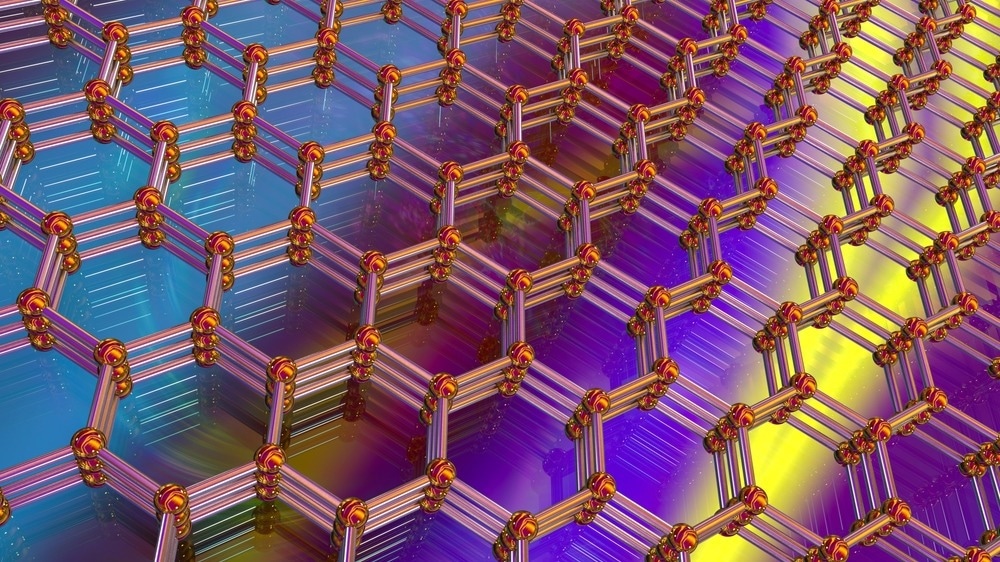Concurrent control over band gap and the charge carrier density in semiconductors is desirable in photodetectors, highly tunable transistors, and lasers. Bernal-stacked bilayer graphene is a van-der-Waals material that permits tuning the band gap by applying an out-of-plane electric field.

Study: Transport Spectroscopy of Ultraclean Tunable Band Gaps in Bilayer Graphene. Image Credit: Kateryna Kon/Shutterstock.com
Despite the discovery of tunable band gap, the fabrication of clean heterostructures with electrically tunable band gap is a recent achievement that is applied to confine charge carriers. An article published in Advanced Electronic Materials discussed gated bilayer graphene with a tunable band gap, characterized by finite-bias transport spectroscopy and temperature-activated transport measurements.
The finite-bias transport spectroscopy helped compare different gate materials and corresponding device technologies, affecting the potential of disorder in bilayer graphene. The graphite-gated bilayer graphene showed a low disorder with no subgap states, leading to tunable band gaps of up to 120 millielectronvolts.
Tunable Band Gaps in Bilayer Graphene
Graphene is a two-dimensional (2D) crystalline form of carbon, extensively applied in electronics and photonics. The monolayer and bilayer graphene structures have a zero-band gap and are prepared by exfoliation from graphite or by chemical vapor deposition (CVD).
The bilayer graphene existing in the AB or Bernal-stacked form has one-half of the associated atoms lying directly over the lower graphene sheet’s hexagon center, and the other half of the atom lie over another atom wherein the layers are aligned perfectly.
The bilayer graphene with zero bandgaps behaves like a semi-metal where the introduction of the bandgap could be possible via generating an electric displacement field between the two layers. Although Bernal stacked bilayer graphene is a 2D semi-metal, the application of an out-of-plane electric field can transform it into a 2D semiconductor, with an electronic band gap that is proportional to the strength of the displacement field.
Even though the tunable band gap was observed using a scanning tunneling spectroscopy, the subgap states in transport measurements caused by disorder could not suppress the electron conduction completely, making such bilayer graphene devices unsuitable for semiconductor applications.
This drawback was neither solved by the fabrication of double-gated structures based on suspended bilayer graphene nor by bilayer graphene encapsulation by hexagonal boron nitride (hBN). To this end, graphite gates-based fabrication technology permitted a gate-controlled band gap, leading to a true band insulating state in bilayer graphene.
Transport Spectroscopy in Bilayer Graphene
In the present study, the graphite gates-based fabrication was used to introduce a tunable band gap in bilayer graphene that was observed via finite bias transport spectroscopy measurement. The band gaps obtained were in concurrence with the theory and the values obtained from thermally activated transport.
The finite bias transport spectroscopy was used to compare hBN device technologies and double-gated bilayer graphene that allowed to probe hopping-transport due to possible disorder or impurity states resulting in the effective tail and subgap states. The study showed that the gates-based fabrication technology impacted the maximum device resistance.
Moreover, this fabrication technology also impacted the finite bias voltage’s suppressed conductance while measuring the transport through electrostatically gapped bilayer graphene and band gap tunability with the electric displacement field.
The results revealed that the behavior of the graphite gate-based bilayer graphene device was as anticipated through theoretical predictions for ideal bilayer graphene, revealing the semiconducting behavior of the device under an applied electric displacement field.
In a graphite gate-based bilayer graphene device, maximum resistance values of 100 gigaohms were observed in a gapped regime with no subgap energy due to trap or impurity states. However, the gold and silicon-gated devices appeared to be affected by disorder and subgap states.
Hence, the gold-gated device showed high gap-induced resistances where the band gap was reduced in finite bias measurements, while no band gap was observed in silicon-gated devices. The overall results confirmed that the bilayer graphene is explorable in graphite gated BLG/hBN heterostructures, revealing its robustness in unleashing the potential of the tunable 2D semiconductor.
Conclusion
To conclude, finite-bias transport spectroscopy was demonstrated as a versatile method for characterizing the bilayer graphene’s band gap. The high sensitivity of this transport spectroscopic method allowed the comparative study based on the influence of electrostatic potentials for various gating technologies.
The measurements from different gating technologies indicated that graphite-gated devices, which were a part of the van der Waals heterostructure, outperformed the gold and silicon-gated devices and behaved closely to the theoretical prediction obtained for ideal bilayer graphene.
The band gaps of up to 120 millielectronvolts were achieved in graphite-gated devices with resistances up to 100 gigaohms. These results highlighted the importance of a graphite-based bottom gate for bilayer graphene-based van-der-Waals heterostructures. Moreover, the excellent quality of graphene/ hBN/ bilayer graphene devices was demonstrated in the present work to address the widespread applications of bilayer graphene.
Reference
Icking, E., Banszerus, L., Wörtche, F., Volmer, F., Schmidt, P., Steiner, C., Engels, et al. (2022) Transport Spectroscopy of Ultraclean Tunable Band Gaps in Bilayer Graphene. Advanced Electronic Materials. https://onlinelibrary.wiley.com/doi/10.1002/aelm.202200510
Disclaimer: The views expressed here are those of the author expressed in their private capacity and do not necessarily represent the views of AZoM.com Limited T/A AZoNetwork the owner and operator of this website. This disclaimer forms part of the Terms and conditions of use of this website.